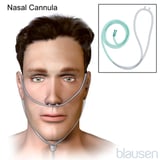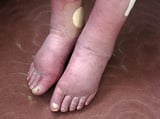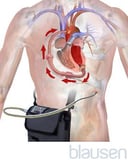History and Physical Examination Report Definition
The medical history and physical examination can suggest that a person has a heart or blood vessel disorder that requires additional testing for accurate diagnosis.
When doctors "take a medical history," they ask people to explain the "story" of what is bothering them. Doctors first ask about symptoms. Chest pain Chest Pain Chest pain is a very common complaint. Pain may be sharp or dull, although some people with a chest disorder describe their sensation as discomfort, tightness, pressure, gas, burning, or aching... read more , shortness of breath Shortness of Breath Shortness of breath—what doctors call dyspnea—is the unpleasant sensation of having difficulty breathing. People experience and describe shortness of breath differently depending on the cause... read more  , awareness of fast or irregular heartbeats (palpitations Palpitations Palpitations are the awareness of heartbeats. The sensation may feel like pounding, fluttering, racing, or skipping beats. Other symptoms—for example, chest discomfort or shortness of breath—may... read more ), fainting Fainting Light-headedness (near syncope) is a sense that one is about to faint. Fainting (syncope) is a sudden, brief loss of consciousness during which the person falls to the ground or slumps in a... read more , dizziness or light-headedness Dizziness or Light-Headedness When Standing Up In some people, particularly older people, blood pressure drops excessively when they sit or stand up (a condition called orthostatic or postural hypotension). Symptoms of faintness, light-headedness... read more , trouble laying flat, and swelling Swelling Swelling is due to excess fluid in the tissues. The fluid is predominantly water. Swelling may be widespread or confined to a single limb or part of a limb. Swelling is often in the feet and... read more
, awareness of fast or irregular heartbeats (palpitations Palpitations Palpitations are the awareness of heartbeats. The sensation may feel like pounding, fluttering, racing, or skipping beats. Other symptoms—for example, chest discomfort or shortness of breath—may... read more ), fainting Fainting Light-headedness (near syncope) is a sense that one is about to faint. Fainting (syncope) is a sudden, brief loss of consciousness during which the person falls to the ground or slumps in a... read more , dizziness or light-headedness Dizziness or Light-Headedness When Standing Up In some people, particularly older people, blood pressure drops excessively when they sit or stand up (a condition called orthostatic or postural hypotension). Symptoms of faintness, light-headedness... read more , trouble laying flat, and swelling Swelling Swelling is due to excess fluid in the tissues. The fluid is predominantly water. Swelling may be widespread or confined to a single limb or part of a limb. Swelling is often in the feet and... read more  (edema) in the legs, ankles, and feet or abdomen suggest a heart disorder.
(edema) in the legs, ankles, and feet or abdomen suggest a heart disorder.
Other, more general symptoms, such as fever, weakness, fatigue, lack of appetite, and a general feeling of illness or discomfort (malaise), may be due to a heart disorder but have many other causes.
Next, doctors ask about
-
Whether a person is sedentary or active
-
Symptoms that occur during exertion or exercise and that are relieved by rest
-
Use of drugs (including prescription, nonprescription, naturopathic, and/or recreational drugs), alcohol, and tobacco
-
Family history of disorders that affect the heart or blood vessels
During the physical examination, doctors may check the person's
-
Weight and overall appearance
-
Vital signs (such as temperature, breathing rate, and blood pressure)
-
Eyes
-
Veins in the neck
-
Heart and lung sounds
-
Pulses
-
Legs and ankles for any signs of swelling
-
Skin
Doctors look for paleness (pallor), sweating, or drowsiness, which may be subtle indicators of heart disorders. The person's general mood and feeling of well-being, which also may be affected by heart disorders, are noted.
The pulse in arteries in the neck, beneath the arms, at the elbows and wrists, in the abdomen, in the groin, at the knees, and in the ankles and feet is felt to assess whether blood flow is adequate and equal on both sides of the body. An abnormality may suggest a heart or blood vessel disorder.
The veins in the neck are inspected while the person is lying down with the upper part of the body elevated at a 45° angle. These veins are inspected because they are directly connected to the right atrium (the upper chamber of the heart that receives oxygen-depleted blood from the body) and thus give an indication of the volume and pressure of blood entering the right side of the heart. Highly distended neck veins suggest abnormally high pressure in the right side of the heart.
By placing a hand on the person's chest, doctors can feel (palpate) where the heartbeat is strongest and thus determine whether the heart is enlarged. The quality and force of contractions during each heartbeat can also be determined. Sometimes abnormal, turbulent blood flow within vessels or between heart chambers causes a vibration (called a thrill) that can be felt with the fingertips or palm.
By listening to (auscultating) the heart with a stethoscope, doctors can hear the distinctive sounds caused by the opening and closing of the heart valves. Abnormalities of the valves and heart structures create turbulent blood flow that causes characteristic sounds called murmurs. Turbulent blood flow typically occurs as blood moves through narrowed or leaking valves. However, not all heart disorders cause murmurs, and not all murmurs indicate a heart disorder. For example, pregnant women usually have heart murmurs because of a normal increase in blood flow. Harmless heart murmurs also are common among infants and children because of the rapid flow of blood through their heart's smaller structure. As blood vessel walls, valves, and other tissues gradually stiffen in older people, blood may flow turbulently, even when no serious heart disorder is present. Also, doctors may hear clicks and snaps when an abnormal valve opens. A gallop rhythm (a sound resembling that of a galloping horse), due to one or two extra heart sounds, is often heard in people who have heart failure Heart Failure (HF) Heart failure is a disorder in which the heart is unable to keep up with the demands of the body, leading to reduced blood flow, back-up (congestion) of blood in the veins and lungs, and/or... read more  .
.
Doctors feel the abdomen to determine if the liver is enlarged. Enlargement may indicate that blood is pooled in the major veins leading to the heart. Swelling of the abdomen due to fluid accumulation may indicate heart failure. By pressing gently on the abdomen, the doctor checks the pulse and determines the width of the abdominal aorta.
If the diagnosis of high blood pressure is in doubt (for example, if the measurements taken in the office vary too much), doctors may recommend that people use a continuous 24-hour blood pressure (BP) monitor. The monitor is a portable battery-operated device, worn on the hip, that is connected to a blood pressure cuff, worn on the arm. This monitor repeatedly records blood pressure throughout the day and night over a 24- or 48-hour period. The readings determine not only whether high blood pressure is present but also how severe it is.
Doctors also often recommend that people with high blood pressure monitor their own blood pressure at home. Self-monitoring may motivate people to follow a doctor's recommendations regarding treatment. One option for home blood pressure monitoring is an inexpensive home blood pressure monitor. The monitor is a portable battery-operated device that people can use to easily take their blood pressure at home using a cuff placed around the wrist or upper arm. Although these monitors are usually not as accurate as the devices used at a doctor's office, they enable people to monitor their blood pressure more frequently and facilitate drug adjustment by their doctor.
History and Physical Examination Report Definition
Source: https://www.merckmanuals.com/home/heart-and-blood-vessel-disorders/diagnosis-of-heart-and-blood-vessel-disorders/medical-history-and-physical-examination-for-heart-and-blood-vessel-disorders
0 Response to "History and Physical Examination Report Definition"
Post a Comment